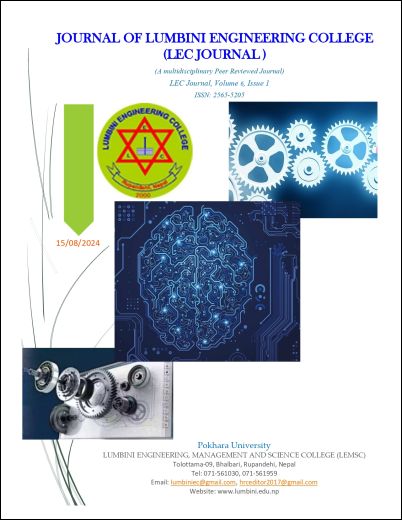Effect of Partial Replacement of Natural Fine Aggregate with Crushed Stone Dust: A Case Study of Makawanpur District
DOI:
https://doi.org/10.3126/lecj.v6i1.66284Keywords:
Concrete, natural fine aggregate, coarse aggregate, crushed stone dust, Makawanpur, compressive strengthAbstract
Stone dust is a waste material produced in stone crusher industry. Stone dust produced from the crushed stone industry is quite numerous. Nowadays in Makawanpur district of Nepal, the availability of high-quality natural fine aggregate has become increasingly limited and expensive due to factors such as restricted river access, illegal dredging, and the rapid surge in construction activities. This situation necessitates the exploration of alternative materials for construction purposes. Crushed stone dust emerges as a compelling substitute, offering an effective solution to partially replace natural fine aggregate in construction applications. To achieve this objective, a meticulous experimental program was designed, involving the creation of cube-shaped specimens. The findings of the study reveal that stone dust can indeed serve as a viable replacement for natural fine aggregate with crushed stone dust, as evidenced by compressive strength measurements. This emphasizes the feasibility and effectiveness of integrating stone dust as a strategic alternative to natural sand in construction endeavors. This study aims to find out the maximum percentage of stone dust to substitute sand in a concrete mix to obtain the maximum strength and good workability. The cement used throughout this work was Ordinary Portland Cement (OPC) of 43 grade. The natural sand was taken from Rapti river and Manahar i river, while the crushed stone dust and coarse aggregate were taken from same source from different crusher of Makawanpur district. The percentages of crushed stone dust replacing natural fine aggregate were varied from 20, 40, 60 and 80% to find out the maximum percentage of crushed stone dust to replace natural fine aggregate from river to produce the maximum compressive strength of concrete. The results of this research showed that the maximum percentage of crushed stone dust, which could replace natural fine aggregate in concrete mixture was 40% with the higher compressive strength than that of concrete with natural sand only. In addition, decreasing the slump value when natural fine aggregate replaced by 20%, 40%, 60% and 80% slightly.
Downloads
Downloads
Published
How to Cite
Issue
Section
License

This work is licensed under a Creative Commons Attribution-NonCommercial 4.0 International License.
This license allows reusers to distribute, remix, adapt, and build upon the material in any medium or format for non-commercial purposes only, and only so long as attribution is given to the creator.




